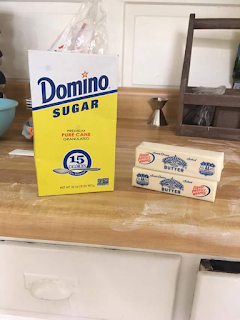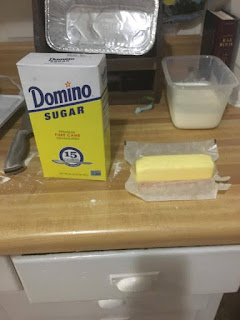I Made Some Biscotti
Video Reflection:
1. I chopped up some almonds before putting them in the over, but I also had a batch that I chopped after I put them in the over. Unfortunately, the picture of the pre-chopped almonds after putting them in the oven is unclear, but they still smelled great :)

2. After combining the dough ingredients together, the dough becomes stiff.


(both doughs are shown here, olive oil on top)
3. Shape the dough into logs:

(Here the butter dough is on the left)

^^^ that's the olive oil dough

^^^ that's the dough made with butter
4. Slice the logs of dough:


I had a bit more trouble cutting the butter one than expected, but there were casualties from both logs for picture-defect biscotti... :'(
5. Final product after baking a couple times:

Olive oil is on the left above.

Olive oil batch (above) and close up (below)


Butter batch (above) and close up (below)

Some Science Questions:
1. I chopped up some almonds before putting them in the over, but I also had a batch that I chopped after I put them in the over. Unfortunately, the picture of the pre-chopped almonds after putting them in the oven is unclear, but they still smelled great :)

2. After combining the dough ingredients together, the dough becomes stiff.


(both doughs are shown here, olive oil on top)
3. Shape the dough into logs:

(Here the butter dough is on the left)

^^^ that's the olive oil dough

^^^ that's the dough made with butter
4. Slice the logs of dough:


I had a bit more trouble cutting the butter one than expected, but there were casualties from both logs for picture-defect biscotti... :'(
5. Final product after baking a couple times:

Olive oil is on the left above.

Olive oil batch (above) and close up (below)


Butter batch (above) and close up (below)

Some Science Questions:
- Based on your observations of the two types of biscotti and your knowledge of fat composition - provide a chemical explanation of how the fat/oil content is responsible for the differences in texture? Think about how each fat/oil would behave when the cookie is sitting at room temperature.
Fat would begin to solidify significantly more at room temperature. This would create stronger bonds in the cookie than the oil. Both fat and oil prevent gluten from forming in the majority of the mixture of the dough, hence the crumble of the cookie.
2. Remember that butter has 20% water - what will happen to that water in the hot oven? How might that impact the texture?
The water will evaporate, potentially drying out the cookie and making a crumbier desert.
3. When mixing the ingredients you added the flour mixture slowly to the fat/oil mixture. What effect does the fat/oil have on gluten formation in the dough? What about your biscotti supports your conclusion?
Fat and oil coat the flour and prevent gluten formation in the dough. As I bite into my biscotti I find that I am covered in crumbs, indicating a weak gluten matrix. There are also not many large holes that form in the cookie, and most of it has smooth texture visually, almost like sand.


Comments
Post a Comment